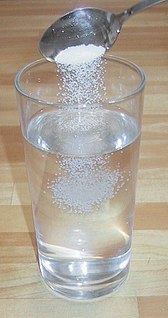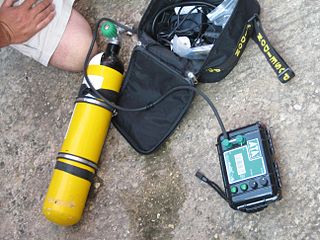In chemistry, concentration is the abundance of a constituent divided by the total volume of a mixture. Several types of mathematical description can be distinguished: mass concentration, molar concentration, number concentration, and volume concentration. A concentration can be any kind of chemical mixture, but most frequently solutes and solvents in solutions. The molar (amount) concentration has variants such as normal concentration and osmotic concentration.
Nitrox refers to any gas mixture composed of nitrogen and oxygen. This includes atmospheric air, which is approximately 78% nitrogen, 21% oxygen, and 1% other gases, primarily argon. In the usual application, underwater diving, nitrox is normally distinguished from air and handled differently. The most common use of nitrox mixtures containing oxygen in higher proportions than atmospheric air is in scuba diving, where the reduced partial pressure of nitrogen is advantageous in reducing nitrogen uptake in the body's tissues, thereby extending the practicable underwater dive time by reducing the decompression requirement, or reducing the risk of decompression sickness.

In chemistry, a solution is a special type of homogeneous mixture composed of two or more substances. In such a mixture, a solute is a substance dissolved in another substance, known as a solvent. The mixing process of a solution happens at a scale where the effects of chemical polarity are involved, resulting in interactions that are specific to solvation. The solution assumes the phase of the solvent when the solvent is the larger fraction of the mixture, as is commonly the case. The concentration of a solute in a solution is the mass of that solute expressed as a percentage of the mass of the whole solution. The term aqueous solution is when one of the solvents is water.
In a mixture of gases, each constituent gas has a partial pressure which is the notional pressure of that constituent gas if it alone occupied the entire volume of the original mixture at the same temperature. The total pressure of an ideal gas mixture is the sum of the partial pressures of the gases in the mixture.
Chemical composition refers to the identity and relative number of the chemical elements that make up any particular compound.
The abundance of the chemical elements is a measure of the occurrence of the chemical elements relative to all other elements in a given environment. Abundance is measured in one of three ways: by the mass-fraction ; by the mole-fraction ; or by the volume-fraction. Volume-fraction is a common abundance measure in mixed gases such as planetary atmospheres, and is similar in value to molecular mole-fraction for gas mixtures at relatively low densities and pressures, and ideal gas mixtures. Most abundance values in this article are given as mass-fractions.

A breathing gas is a mixture of gaseous chemical elements and compounds used for respiration. Air is the most common, and only natural, breathing gas. But other mixtures of gases, or pure gases, are also used in breathing equipment and enclosed habitats such as scuba equipment, surface supplied diving equipment, recompression chambers, submarines, space suits, spacecraft, medical life support and first aid equipment, high-altitude mountaineering and anaesthetic machines.

Oxygen toxicity is a condition resulting from the harmful effects of breathing molecular oxygen at increased partial pressures. Severe cases can result in cell damage and death, with effects most often seen in the central nervous system, lungs, and eyes. Historically, the central nervous system condition was called the Paul Bert effect, and the pulmonary condition the Lorrain Smith effect, after the researchers who pioneered the discoveries and descriptions in the late 19th century. Oxygen toxicity is a concern for underwater divers, those on high concentrations of supplemental oxygen, and those undergoing hyperbaric oxygen therapy.
In underwater diving activities such as saturation diving, technical diving and nitrox diving, the maximum operating depth (MOD) of a breathing gas is the depth below which the partial pressure of oxygen (pO2) of the gas mix exceeds an acceptable limit. This limit is based on risk of central nervous system oxygen toxicity, and is somewhat arbitrary, and varies depending on the diver training agency or Code of Practice, the level of underwater exertion planned and the planned duration of the dive, but is normally in the range of 1.2 to 1.6 bar.

Gas blending for scuba diving is the filling of diving cylinders with non-air breathing gases such as nitrox, trimix and heliox. Use of these gases is generally intended to improve overall safety of the planned dive, by reducing the risk of decompression sickness and/or nitrogen narcosis, and may improve ease of breathing.
Developed by Adolf Eugen Fick (1829–1901), the Fick principle has been applied to the measurement of cardiac output. Its underlying principles may also be applied in a variety of clinical situations.
Mixtures of dispersed combustible materials and air will burn only if the fuel concentration lies within well-defined lower and upper bounds determined experimentally, referred to as flammability limits or explosive limits. Combustion can range in violence from deflagration through detonation.
Plasma protein binding refers to the degree to which medications attach to proteins within the blood. A drug's efficiency may be affected by the degree to which it binds. The less bound a drug is, the more efficiently it can traverse cell membranes or diffuse. Common blood proteins that drugs bind to are human serum albumin, lipoprotein, glycoprotein, and α, β‚ and γ globulins.
Equivalent narcotic depth (END) is used in technical diving as a way of estimating the narcotic effect of a breathing gas mixture, such as heliox and trimix. The method is, for a given mix and depth, to calculate the depth which would produce the same narcotic effect when breathing air.
Fraction of inspired oxygen (FiO2) is the fraction of oxygen in the volume being measured. Medical patients experiencing difficulty breathing are provided with oxygen-enriched air, which means a higher-than-atmospheric FiO2. Natural air includes 21% oxygen, which is equivalent to FiO2 of 0.21. Oxygen-enriched air has a higher FiO2 than 0.21; up to 1.00 which means 100% oxygen. FiO2 is typically maintained below 0.5 even with mechanical ventilation, to avoid oxygen toxicity.

A Helium analyzer is an instrument used to identify the presence and concentration of helium in a mixture of gases. In Technical diving where breathing gas mixtures known as Trimix comprising oxygen, helium and nitrogen are used, it is necessary to know the fraction of helium in the mixture to reliably calculate decompression schedules for dives using that mixture.

Rebreather diving is underwater diving using rebreathers, which recirculate the breathing gas already used by the diver after replacing oxygen used by the diver and removing the carbon dioxide metabolic product. Rebreather diving is used by recreational, military and scientific divers in applications where it has advantages over open circuit scuba, and surface supply of breathing gas is impracticable. The main advantages of rebreather diving are extended gas endurance, and lack of bubbles.
Oxygen compatibility is the issue of compatibility of materials for service in high concentrations of oxygen. It is a critical issue in space, aircraft, medical, underwater diving and industrial applications.
Aspects include effects of increased oxygen concentration on the ignition and burning of materials and components exposed to these concentrations in service.
Gas blending is the process of mixing gases for a specific purpose where the composition of the resulting mixture is specified and controlled.
A wide range of applications include scientific and industrial processes, food production and storage and breathing gases.







